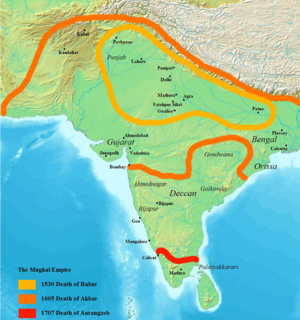Alamgir II
| Alamgir | ||
|---|---|---|
| Emperor of Mughal Empire | ||
| Reign | 1754-1759 | |
| Born | 1699 | |
| Died | 1759 | |
| Predecessor | Ahmad Shah Bahadur | |
| Successor | Shah Jahan III | |
Alamgir II (عالمگير ۲) (1759 - 1699) also known as Aiz-ud-din was the 16th emperor of India between 1754 and 1759. He was the son of Jahandar Shah and the tenth of the "later Moghuls" under whose rule the Empire disintegrated, and was finally wound-up by the British who, although technically agents of the last Emperor, sent him into exile following the so-called Mutiny of 1857.
Life
Aziz-ud-Din, the second son of Jahandar Shah, was raised to the throne by Ghazi-ud-Din after he deposed Ahmad Shah Bahadur in 1754, whom he blinded and and later killed (1775). During Ahmad Shah's reign, the Persian ruler, Nader Shah had sacked Delhi (1738-9) and carried off both the Peacock Throne and the Koh-i-Noor diamond, both symbols of Moghul prestige and so much treasure that Persians subsequently enjoyed a three year holiday from taxation. The Vizier, whose own grand-father ruler the State of Hyderababd from 1720 until his death in 1748, was effectively the ruler of the Empire under both Ahmad Shah and Alamgir II. Since he could not claim the throne himself, he tried to control it by ruling through weaker men who had the advantage of belonging to the Moghul dynasty.
On ascending the throne, he took the title of Alamgir and tried to follow the approach of Aurangzeb Alamgir. At the time of his accession to throne he was an old man of 55 years. He had no experience of administration and warfare as he had spent most of his life in jail. He was a weak ruler, with all powers vested in the hand of his Wazir, Ghazi-ud-Din Imad-ul-Mulk. In 1756, Ahmad Shah Abdali invaded India once again and captured Delhi and plundered Mathura. Marathas became more powerful because of their collaboration with Ghazi-ud-Din, and dominated the whole of northern India. This was the peak of Maratha expansion, which caused great trouble for the Mughal Empire, already weak with no strong ruler.
The relations between Alamgir and his Wazir, Ghazi-ud-Din, by this time had gotten worse. Alamgir was murdered by Nawab Mir Nawab Mir Ghaziudin Khan Bahadur (grandson of Asaf Jah I), and the son of Alamgir, Ali Gauhar succeeded him.
ReferencesISBN links support NWE through referral fees
- Eraly, Abraham. 2004. The Mughal throne: the saga of India's great emperors. London: Phoenix ISBN 9780753817582
- Hansen, Waldemar. 1972. The Peacock Throne; the drama of Mogul India. New York: Holt, Rinehart and Winston ISBN 9780030002717
- Richards, John F. 1993. The Mughal Empire. The New Cambridge history of India, I, 5. Cambridge: Cambridge University Press ISBN 9780521251198
- Robinson, Francis. 2007. The Mughal emperors and the Islamic dynasties of India, Iran and Central Asia, 1206-1925. New York: Thames & Hudson ISBN 9780500251348
| Preceded by: Ahmad Shah Bahadur |
Mughal Emperor 1754–1759 |
Succeeded by: Shah Jahan III |
Credits
New World Encyclopedia writers and editors rewrote and completed the Wikipedia article in accordance with New World Encyclopedia standards. This article abides by terms of the Creative Commons CC-by-sa 3.0 License (CC-by-sa), which may be used and disseminated with proper attribution. Credit is due under the terms of this license that can reference both the New World Encyclopedia contributors and the selfless volunteer contributors of the Wikimedia Foundation. To cite this article click here for a list of acceptable citing formats.The history of earlier contributions by wikipedians is accessible to researchers here:
The history of this article since it was imported to New World Encyclopedia:
Note: Some restrictions may apply to use of individual images which are separately licensed.

